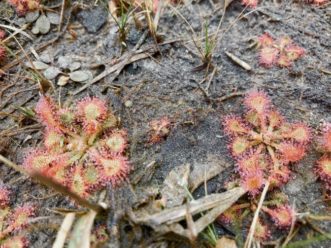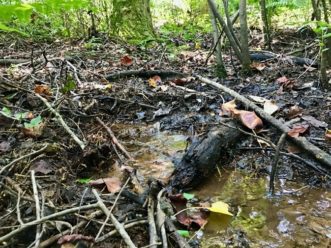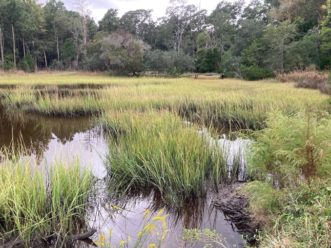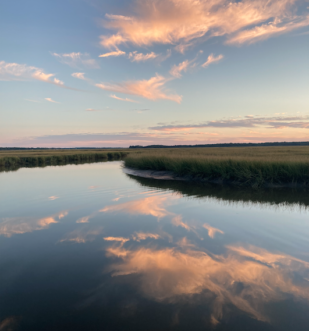This publication describes the importance of wetlands through a discussion of the ecology, ecosystem services, history, and policy of wetland ecosystems. With a particular focus on South Carolina wetlands, this article targets extension agents, landowners, land managers, and conservation professionals, who can use this overview to better understand the status and importance of wetland ecosystems. Additional Land-Grant Press publications related to wetlands are available on the Clemson Cooperative Extension Land-Grant Press website (lgpress.clemson.edu): “Valuing Ecosystem Services of Coastal Marshes and Wetlands,” “South Carolina’s Coastal Habitats and Regional Comparison,” and “How the 2020 Definition of WOTUS Affects Agricultural and Specialty Crop Producers.”
Introduction
Wetland ecosystems are often found at the transition between aquatic and terrestrial environments or in lower elevations within the landscape. Characterized by the presence of water (for at least part of the growing season each year), hydrophytic vegetation, and hydric soils, wetlands provide important habitat for plants and animals and harbor a high degree of biological diversity. This is especially true for threatened and endangered species, one-third of which require wetlands for survival.1 Wetlands also provide valuable ecosystem services such as flood prevention and water quality control.2 Unfortunately, wetlands have been lost at an alarming rate; twenty-two states have lost more than half of their wetlands in the past two centuries.3 However, greater awareness of the ecological and economic importance of wetlands has led to increased protections in recent years.
What is a Wetland?
Wetlands vary in numerous ways, including size and geomorphic setting, but are similar in that they share the following characteristics4:
- Support hydrophytic vegetation
- Soils are primarily poorly drained hydric soils
- Saturated or flooded by water for an extended duration during the growing season
Some wetlands, such as riparian wetlands, serve as transitional zones between dry upland areas and aquatic habitat, while others, such as Carolina Bays, lack a surface water connection to permanent waterways.
Wetland Types in South Carolina
In South Carolina, nearly 4.6 million acres are categorized as wetlands, of which 90% are freshwater.5 Roughly one-quarter of the total land area of South Carolina is characterized as a wetland, ranking South Carolina as the state with the third highest percentage of land area as wetlands.6
Wetlands are generally categorized as coastal/tidal wetlands or inland/non-tidal wetlands. Coastal wetlands in South Carolina are found along the Atlantic coast and are influenced by seawater. Salinity and fluctuating water levels create unsuitable conditions for many plants; thus, coastal salt marshes in South Carolina are predominately a monoculture of the salt-tolerant Spartina alterniflora.
The US Fish and Wildlife Service specifically categorizes wetlands into five ecological systems based on Cowardin et al. (1979)7: palustrine, lacustrine, riverine, estuarine, and marine.
- Palustrine systems are non-tidal wetlands with vegetation dominated by trees, shrubs, or emergent vegetation and are often referred to as freshwater forested wetlands. Palustrine systems are smaller than twenty acres and are less than 6.6 feet deep. They are estimated to make up 70% of the total wetland area and include bottomland hardwood forests, swamps, and Carolina bays.8
- Lacustrine ecosystems are non-tidal areas, including wetlands and deepwater habitats found in depressions or dammed rivers. Unlike Palustrine systems, lacustrine areas lack trees, shrubs, and persistent emergent vegetation and instead have submerged or floating plants with periodic emergent vegetation. Lacustrine wetlands are larger than twenty acres and deeper than 6.6 feet. Examples of lacustrine wetlands are the shallow areas of permanently flooded lakes and reservoirs.
- Riverine ecosystems are found in floodplain and riparian areas of river channels. One example is a spring that discharges into a river channel. Riverine systems have salinity under 0.5% and are almost always flowing.
- Estuarine ecosystems are tidal wetlands that receive low wave energy, have a salinity level greater than 0.5%, and can even have a higher amount of salt relative to the ocean due to freshwater evaporation and resulting concentration of salt. This system includes lagoons and estuaries.8
- Marine systems are similar to estuarine systems but receive more intense wave action and have a salinity of more than 30%.
Within each of the five wetland ecosystems, there are a wide variety of wetland types. Common wetland types found across South Carolina include Carolina Bays, Pocosins, bogs, seeps, bottomland hardwood forests (such as those found in Congaree National Park), tidal freshwater marshes, and tidal salt marshes.
Carolina Bays may be the most interesting of South Carolina’s wetlands, and their origin remains unknown to this day. Carolina Bays are elliptical or oval depressions that are oriented northwest to southeast and are mainly found in the Carolinas. Carolina Bays are sustained by rainwater and are generally shallow with sandy bottoms.9
Bogs consist of spongy peat deposits, often have sphagnum moss present, and may be referred to as Pocosins in the Southeast. Like Carolina Bays, bogs receive their primary input of freshwater from precipitation. Bogs can harbor a unique array of carnivorous plants, such as the pitcher plant (Sarracenia), sundews (Drosera), and Venus fly traps (Dionacaea muscipula)9 (figure 1).
Seeps are wetlands characterized by groundwater emanating from the surface (figure 2). Unlike springs, seeps have no distinct channel and are small relative to other wetland types. They also are commonly found on slopes or at the base of slopes in forested areas.10
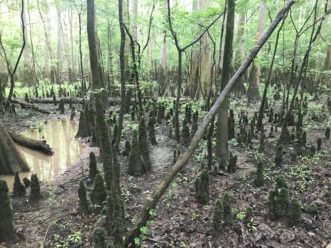
Figure 3. The knees of cypress trees at Congaree National Park break the surface. Image credit: Karen Jackson, Clemson Cooperative Extension.
Bottomland hardwood forests are deciduous forested wetlands that occur along the floodplain of rivers and streams in the southern (south central and southeastern) United States. Commonly referred to as “swamps,” these systems generally experience fluctuating water levels throughout the year and provide water storage capacity when rivers and streams overflow their banks. Baldcypress trees (Taxodium distichum) are an easily recognizable feature of many bottomland hardwood forests, notable for their distinctive “knees” (figure 3).
Tidal freshwater marshes are common across coastal South Carolina (figure 4); these wetlands experience tidal fluctuations but are far enough inland that they do not experience salinity stress. Many tidal freshwater marshes were altered for rice cultivation in the 1800s, and the remaining impoundments are often used for waterfowl today.
Salt marshes paint a quintessential scene of the Carolina coast (figure 5). Found along protected coastlines, salt marshes can be harsh environments due to salt stress and tidal fluctuations. They are dominated by Spartina alterniflora, a salt-tolerant cordgrass, and a variety of other plants and animals that are adapted to the high salinity environment.
For more on the coastal wetlands of South Carolina, see the Land-Grant Press publication “South Carolina’s Coastal Habitats and Regional Comparison.”
History of Wetlands
In the 1600s, wetlands likely covered 221 million acres across the conterminous United States.3 Wetlands were often converted for colonial settlement and agricultural expansion. Neither the intrinsic value nor ecosystem services of wetlands were adequately understood at this time. Due to their fertile soil, many wetlands were converted to agricultural fields, including in South Carolina, where cotton and tobacco farming was predominant. Between the 1780s and the 1980s, South Carolina lost 27% of its wetlands due to land conversion.11 Additionally, bottomland swamps were extensively harvested as the bald cypress trees (Taxodium distichum) were prized for their termite and rot-resistant qualities. In the midlands of South Carolina, Congaree National Park preserves the largest intact hardwood forested swamp remaining in the Southeast.12 During the 1900s, the government financially supported the conversion of wetlands through programs like the Sugar Act of 1934, the Watershed Protection and Flood Prevention Act, and the Agriculture Conservation Program. The first program to protect wetlands was the Migratory Bird Hunting Stamp Act of 1934. However, substantial actions to preserve and protect wetlands were not taken until the 1970s, with the implementation of the Clean Water Act. By the 1980s, wetland loss in the last century was estimated to be 27%.3
Wetlands Policy
Section 404 of the Clean Water Act oversees the protection of wetlands. Section 404 requires landowners or developers to seek permits before performing activities that dispose of dredged or fill material in “Waters of the United States,” including wetlands.13 However, the definition of Waters of the United States has been under debate in the Supreme Court numerous times, including the case Rapanos v. United States, 547 U.S. 715 (2006), which stated wetlands must possess a “significant nexus” to navigable water to be protected by the Clean Water Act. The phrase “significant nexus” led to further confusion and is still debated today. The main point of contention is whether geographically isolated wetlands that are non-adjacent to navigable Waters of the United States should be protected under federal jurisdiction. Multiple scientific studies documented that although wetlands may be geographically isolated, they are not functionally isolated and still affect overall biodiversity, population dynamics, and nutrient exchange with other Waters of the United States.14,15,16,17 It is important to note that while some wetlands are not classified as jurisdictional wetlands (i.e., not receiving protection through the Clean Water Act), they are still wetland ecosystems and provide valuable ecosystem services that benefit society.
Importance of Wetlands
Worldwide, wetlands are an extremely valuable yet increasingly vulnerable ecosystem. They provide the most ecosystem services of any ecosystem type, including flood protection, water quality improvement, groundwater recharge, and nutrient retention.18
Nutrients and Sediment
Wetlands often serve as transitional areas between terrestrial and aquatic environments, intercepting runoff before it discharges to water bodies. Urban systems with a relatively high percentage of impervious surface can transport large amounts of nutrients and sediment into wetlands and waterways.19 Excess nutrients, such as nitrogen and phosphorus, can have adverse effects on waterways by stimulating nuisance algal growth, which can ultimately decrease dissolved oxygen levels and harm aquatic organisms.20 Sediment can negatively affect water quality, as it decreases water clarity, smothers aquatic plants and sessile animals, and adsorbs pollutants such as bacteria, heavy metals, pesticides, and nutrients. Additionally, Struck et al. found that turbidity increases were associated with bacteria increases in wetland mesocosms.21
Biodiversity
Wildlife Habitat
Wetlands provide habitat for a variety of animal species and are particularly important to animals that depend on both aquatic and terrestrial environments for survival. Some examples of these include Southern leopard frogs (Lithobates sphenocephalus), beaver (Castor canadensis), and muskrats (Ondatra zibethicus).22,23 Plant diversity is also high in wetlands, with an estimated 8,000 or more species included on the National Wetland Plant List.24 Additionally, a relatively large proportion of threatened and endangered species are dependent on wetlands at some point during their life.25,26 Across the continental United States, 50% of the endangered, threatened, or vulnerable animal species spend some of their lives in or around wetlands, while roughly 28% of plants are wetland-dependent.26 Examples of endangered or threatened wetland species in South Carolina include the frosted flatwoods salamander (Ambystoma cingulatum), Carolina gopher frog (Lithobates capito), diamondback terrapin (Malaclemys terrapin), and bunched arrowhead (Sagittaria fasciculata)27,28,29 (figure 6).
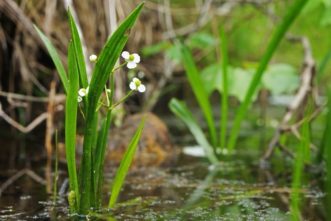
Figure 6. Bunched arrowhead (Sagittaria fasciculata) is a small herbaceous plant found in seepage areas in the Piedmont region of South Carolina. Image credit: Gary Peeples, US Fish and Wildlife Service.
Water Storage
Water moving across the landscape will generally flow to areas of the lowest elevation, which is where wetlands most often occur. The water storage capacity of wetlands, especially those within the floodplain, can help to reduce flood pulses and provide storm protection for nearby communities.30 Conversely, filling in wetlands and removing the storage potential they provide can exacerbate flooding to adjacent and downstream landscapes.
Carbon Storage
Wetlands are known to both sequester carbon (sinks) and release carbon (sources) under certain conditions. Wetlands store carbon primarily through the accumulation of organic matter. Decomposition is slowed in anaerobic environments, so decaying plants accumulate, sequestering organic carbon in the sediment. It is estimated that wetlands in the United States provide between 20% to 30% of global carbon storage.31 While wetlands can provide long-term storage of carbon, when they are drained or otherwise disturbed by anthropogenic activities, that stored organic carbon can be released into the atmosphere via decomposition.
Current Threats to Wetland Ecosystems
One of the most significant threats to wetlands is development and associated land-use change. Development generally increases impervious surfaces, changing the hydrology of an ecosystem, exacerbating runoff, and reducing the potential for infiltration. Wetlands can be inundated with excess runoff or, in some cases, bypassed altogether. The population of South Carolina has grown an estimated 11% since 2010, making it the tenth fastest growing state in the nation.32 This population growth has led to an increase in development, resulting in increased impervious surfaces and less natural cover. For example, Charleston County saw a 21% increase in developed area and a 23% increase in impervious area between 1996 and 2016.33 Land development can disrupt ecosystem services associated with wetlands, reducing species richness and biodiversity.34 Private landowners and land managers can play an important role in preserving and protecting the remaining wetlands on their property. Wetlands mitigation banking, which restores and preserves wetlands (i.e., “banks” them) to compensate for unavoidable impacts to wetlands elsewhere, can provide economic incentives for landowners and managers to preserve existing wetlands on their property.
Climate Change
Climate change research has shown various adverse effects on wetlands depending on their location across the United States. For instance, during the twenty-first century, climate change in coastal areas will result in an estimated 20 cm–60 cm of sea level rise.35 Wetlands can adapt to sea level rise by accreting vertically and migrating inland. However, increased rates of land development could hinder this natural migration.36 Wetlands located in inland areas of the southeastern United States are predicted to become drier due to evapotranspiration and water table depth declines ranging 4 cm–22 cm.36 In the northern plains of the United States, research suggests increases in temperatures will alter wetland hydrology, resulting in wetland loss due to drying.37
Water Withdrawal
Groundwater provides South Carolina with many ecosystem services, including power production, public water supply, and irrigation for crops.38 However, when groundwater resources are used at a rate that exceeds aquifer recharge, wetland hydrology can be altered and even destroyed.39 Beginning in 2001, anyone in South Carolina withdrawing three million gallons or more per month must register and report use to the South Carolina Department of Health and Environmental Control.38 By monitoring groundwater use, the state can better prepare for increases in demands on our water resources and how they may impact groundwater-fed wetlands.
Conclusion
Wetlands provide countless benefits, from flood control and improved water quality to habitat for threatened and endangered species and carbon storage. Increased knowledge of the ecosystem services provided by wetlands, public outreach and education, and wetland monitoring have all led to a decrease in the rate of loss. The US Fish and Wildlife Service has estimated wetland losses in the United States since the 1780s, and in 2004, for the first time, the agency reported that net wetland gains had surpassed net wetland losses.40,41 Wetland gains, particularly in coastal areas that are dealing with the effects of sea level rise, may help communities to better manage stormwater runoff and reduce tidal flooding. This progress is encouraging for conservationists, biologists, and educators working to preserve and restore our remaining wetlands.
References Cited
- Wetlands: Why are Wetlands Important? Washington (DC): US Environmental Protection Agency; 2022 Mar [accessed 2021 Dec 13]. https://www.epa.gov/wetlands/why-are-wetlands-important.
- Maltby E, Acreman MC. Ecosystem services of wetlands: pathfinder for a new paradigm. Hydrological Sciences Journal. 2011;56(8):1341–1359.
- Dahl TE, Johnson CE. Wetlands: status and trends in the conterminous United States, mid-1970’s to mid-1980’s. Washington (DC): US Department of the Interior, Fish and Wildlife Service, Report to Congress; 1991 [accessed 2021 May 17]. 28 p. https://www.fws.gov/wetlands/documents/Wetlands-Status-and-Trends-in-the-Conterminous-United-States-Mid-1970s-to-Mid-1980s.pdf.
- Wetlands: What is a Wetland? Washington (DC): US Environmental Protection Agency; 2022 May [accessed 2021 May 17]. https://www.epa.gov/wetlands/what-wetland.
- State wetland protection: Status, trends and model approaches. A 50-state study by the Environmental Law Institute. Washington (DC): Environmental Law Institute; 2008. [accessed 2022 Jan 22]. https://www.eli.org/sites/default/files/docs/core_states/South_Carolina.pdf.
- Meador MR. South Carolina: wetland resources. Columbia (SC): US Geological Survey; [accessed 2021 Dec 13]. National Water Summary, Wetland Resources. Water Supply Paper 2425. https://www.fws.gov/wetlands/data/Water-Summary-Reports/National-Water-Summary-Wetland-Resources-South-Carolina.pdf.
- Cowardin LM, Carter V, Golet FC, LaRoe ET. Classification of wetlands and deepwater habitats of the United States. Washington (DC): US Department of Interior, Fish and Wildlife Service; 1979 Dec [accessed 2021 Apr 29]. FWS/OBS-79/31. https://www.fws.gov/wetlands/documents/classification-of-wetlands-and-deepwater-habitats-of-the-united-states.pdf.
- USFWS Classification of Wetlands and Deepwater Habitats of the United States: Estuarine System. [accessed 2021 May 17]. https://www.fws.gov/wetlands/documents/classification-of-wetlands-and-deepwater-habitats-of-the-united-states.pdf.
- SCDNR. Advance identification of Carolina bays for South Carolina wetlands protection. Columbia (SC): SC Department of Natural Resources, Land, Water, and Conservation Division; 1999 Mar [accessed 2021 May 17]. Grant No.: CD994920-96-0. Sponsored by US Environmental Protection Agency Region 4, Wetlands Protection Division. https://www.dnr.sc.gov/wildlife/docs/CarolinaBays.pdf.
- Thompson EH, Sorenson ER. Seeps and vernal pools. In: Wetland, woodland, wildland: a guide to the natural communities of Vermont. Montpelier (VT): Vermont Department of Fish and Wildlife. Jointly published by The Nature Conservancy. Available from: University Press of New England, Lebanon, NH. 2005 [accessed 2021 May 17]. p. 302–308. https://dec.vermont.gov/sites/dec/files/wsm/wetlands/docs/5._Seeps_and_Vernal_Pools.pdf.
- Dahl TE. Wetlands: losses in the United States, 1780’s to 1980’s. Washington (DC): US Fish and Wildlife Service, Report to Congress; 1990 [accessed 2022 Jan 22]. 13 p. https://www.fws.gov/wetlands/documents/Wetlands-Losses-in-the-United-States-1780s-to-1980s.pdf.
- Congaree: Home of Champions. Washington (DC): US Department of the Interior, National Park Service. [accessed 2021 Dec 13]. https://www.nps.gov/cong/index.htm.
- 33 U.S.C §§ 1251 et seq.
- Mamta S. Isolated wetlands: assessing their values and functions. Journal of Aquatic Science. 2015;3:6-13.
- Semlitsch RD, Bodie JR. Are small, isolated wetlands expendable? Conservation Biology. 2001; 2(5):1129–1133.
- Leobowitz S. Isolated wetlands and their functions: an ecological perspective. Wetlands. 2003;23:517–531.
- Cohen MJ, Creed IF, Alexander L, Basud NB, Calhoun AJK, Craft C, D’Amico E, DeKeyser E, Fowler L, Golden HE, et al. Do geographically isolated wetlands influence landscape functions? Proceedings of the National Academy of Sciences of the United States of America. 2016 Feb;113(8):1978-1986. doi:10.1073/pnas.1512650113.
- Wetlands: Classification and Types of Wetlands. Washington (DC): US Environmental Protection Agency. 2022 Jan [accessed 2021 May 17]. https://www.epa.gov/wetlands/classification-and-types-wetlands#bogs.
- Costanza R, d’Arge R, de Groot R, Farber S, Grasso M, Hannon B, Limburg K, Naeem S, O’Neill RB, Paruelo J, et al. The value of the world’s ecosystem services and natural capital. Nature. 1997;287:253–260.
- Reinelt L, Horner R, Azous A. Impacts of urbanization on palustrine (depressional freshwater) wetlands—research and management in the Puget Sound region. Urban Ecosystems. 1998; 2:219–236.
- Struck SD, Selvakumar A, Borst M. Performance of retention ponds and constructed wetlands for attenuating bacterial stressors. In: Proceedings, 2007 World Environment and Water Resources Congress, Restoring our Natural Habitat; 2007 May 15–19; Tampa, FL. Reston (VA): American Society of Civil Engineers (ASCE); c2007. [accessed 2021 Jun 3]. https://cfpub.epa.gov/si/si_public_file_download.cfm?p_download_id=460760&Lab=NRMRL.
- Stevenson DJ. Born of new water. South Carolina Wildlife. 2009 Jan/Feb [accessed 2022 Jan 31]. https://www.dnr.sc.gov/magazine/articles/janfeb2009/newwater.html.
- May HL. Wetland mammals: fish and wildlife habitat management leaflet. Washington (DC): US Department of Agriculture, National Resources Conservation Service (NRCS). Jointly published by the Wildlife Habitat Management Institute and Wildlife Habitat Council. 2001 Mar [accessed 2022 Jan 31]. https://efotg.sc.egov.usda.gov/references/public/SC/Wetland_Mammals.pdf.
- Niering WA. Endangered, threatened and rare wetland plants and animals of the continental United States. In: Hook DD, McKee WH, Smith HK, Gregory J, Burrell VG, DeVoe MR, Sojka RE, Gilbert S, Banks R, Stolzy LH, et al. The ecology and management of wetlands. New York (NY): Springer Nature; c1988. p. 227–238.
- Boylan KD, MacLean DR. Linking species loss with wetlands loss. National Wetlands Newsletter. 1997;19(6):13–17.
- Gibss JP. Wetland loss and biodiversity conservation. Conservation Biology. 2001;14(1):314–317.
- Conserving South Carolina’s at-risk species: Species facing threats to their survival. U.S. Fish and Wildlife Service. [accessed 2022 Jan 31].
- Frosted flatwoods salamander (Ambystoma cingulatum). Washington (DC): US Fish and Wildlife Service. [accessed 2022 Jan 31]. https://ecos.fws.gov/ecp/species/4981.
- Cherry JA. Ecology of wetland ecosystems: water, substrate, and life. Nature Education Knowledge. 2011;3(10):16.
- Nahlik AM, Fennessy MS. Carbon storage in US wetlands. Nature Communications. 2016;7:13835.
- Quick Facts: South Carolina. Suitland (MD): United States Census Bureau; 2021 Jul [accessed 2021 May 14]. https://www.census.gov/quickfacts/fact/table/SC/PST045219.
- CCAP Land Cover Atlas. Washington (DC): National Oceanic and Atmospheric Administration (NOAA), Office for Coastal Management, Coastal Change and Analysis Program. [accessed 2021 May 14]. https://coast.noaa.gov/ccapatlas/.
- Houlahan J, Keddy PA, Makkay K, Findlay CS. The effects of adjacent land use on wetland species richness and community composition. Wetlands. 2006;26(1):79–96.
- Day JW, Christian RR, Boesch DM, Yanez-Arancibia A, Morris J, Twilley RR, Naylor L, Schaffner L, Stevenson C. Consequences of climate change on the ecogeomorphology of coastal wetlands. Estuaries and Coasts. 2008;31:477–491.
- Zhu J, Sun G, Li W, Zhang Y, Miao G, Noormets A, McNulty SG, King, JS, Kumar M, Wang, X. Modeling the potential impacts of climate change on the water table level of selected forested wetlands in the southeastern United States. Hydrology Earth System Sciences. 2017;21:6289–6305.
- Poff NL, Brinson MM, Day Jr. JW. Aquatic ecosystems & global climate change: potential impacts on inland freshwater and coastal wetland ecosystems in the United States. Washington (DC): Pew Charitable Trusts; 2002 Jan [accessed 2022 Jan 31]. Prepared for the Pew Center on Global Climate Change. https://www.pewtrusts.org/-/media/legacy/uploadedfiles/wwwpewtrustsorg/reports/protecting_ocean_life/envclimateaquaticecosystemspdf.pdf.
- Craig B, Monroe LA South Carolina water use report 2020 summary. Columbia (SC): SC Department of Health and Environmental Control, Bureau of Water; 2021 Aug [accessed 2022 Jan 31]. Technical Document No: 018-2020. https://scdhec.gov/sites/default/files/media/document/2020_South_Carolina_Water_Use.pdf.
- Marella RL, Berndt MP. Water withdrawals and trends from the Floridan aquifer system in the southeastern United States, 1950–2000. Reston (VA): US Geological Survey; 2005 [accessed 2022 Jan 31]. USGS Survey Circular 1278. https://pubs.usgs.gov/circ/2005/1278/pdf/cir1278.pdf.
- James A. Saving the nation’s wetlands. Washington (DC): US Department of Agriculture, Natural Resources Conservation Service; 2017. [accessed 2022 Feb 28]. https://www.usda.gov/media/blog/2015/06/25/saving-nations-wetlands.
- Dahl TE. Status and trends of wetlands in the conterminous United States 1998 to 2004. Washington (DC): Fish and Wildlife Service; 2005. [accessed 2022 Feb 28]. https://www.fws.gov/wetlands/documents/Status-and-Trends-of-Wetlands-in-the-Conterminous-United-States-1998-to-2004.pdf.

